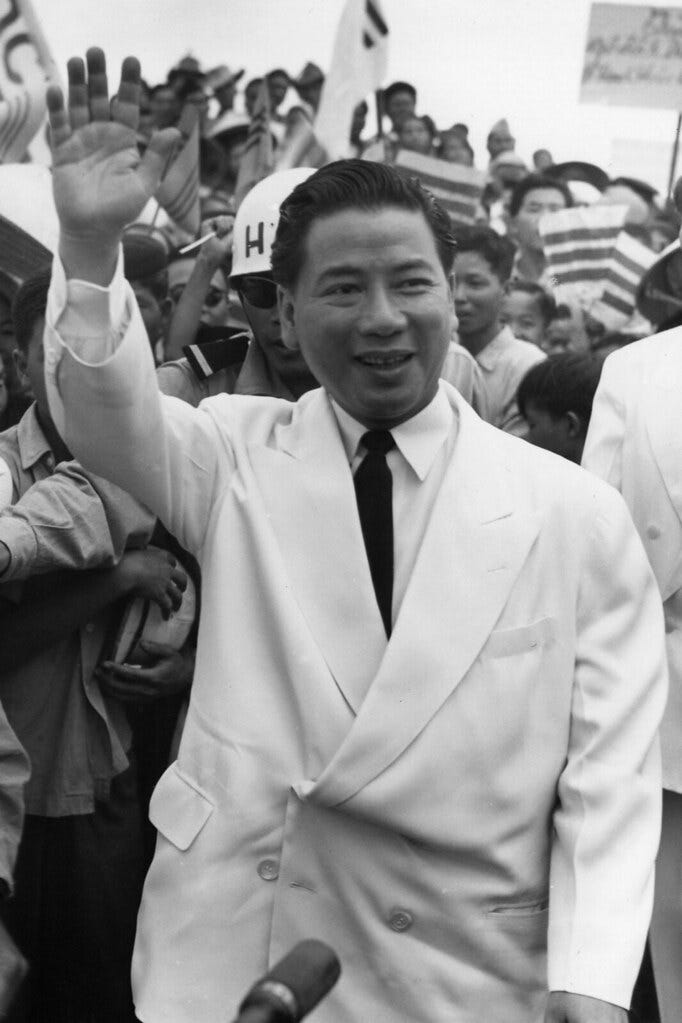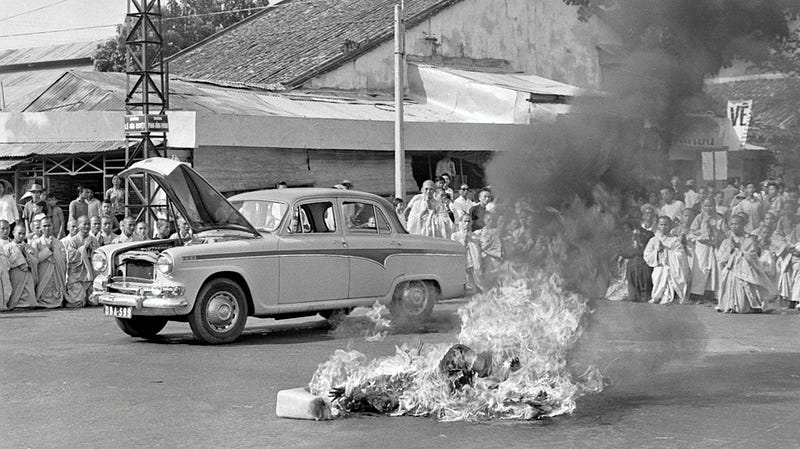 une 11th, 1963 will always be remembered as the day that truly changed history forever. This was the day monk Thich Quang Duc burned himself to death as a protest against the Vietnamese corrupt government which was implying very demanding and unfair laws on monks. Throughout history, many people have self-immolated for various causes, but until that moment no one was known to suicide in such a gruesome and painful way in order to protest against something or for the right of a community such as the sacred monks.
une 11th, 1963 will always be remembered as the day that truly changed history forever. This was the day monk Thich Quang Duc burned himself to death as a protest against the Vietnamese corrupt government which was implying very demanding and unfair laws on monks. Throughout history, many people have self-immolated for various causes, but until that moment no one was known to suicide in such a gruesome and painful way in order to protest against something or for the right of a community such as the sacred monks.
The story behind this act
Most if not all events that had taken place throughout history were influenced by a previous event, the same case is in this story too. The influential event took place on May 8th, 1963 when the Buddhist community was celebrating a special day in the city of Hue. This special day is called Phat Dan or better described as the birthday of Buddha. The streets were crowded with people from all over Vietnam who came to celebrate this special day among monks. An imperative aspect that I have to mention is that most people were waving Buddhist flags.

This aspect is very important as at the time, it was illegal in Vietnam to display a religious flag. This law was implemented by President Ngo Dinh Diem who was a Catholic. The law was implemented as he wanted to make Vietnam more prosperous by “westernizing” it. This law was never welcomed by the population of Vietnam as 90% of the nation was in fact Buddhist. As in most countries and nations, religion was a big part of Vietnamese culture, and trying to change the culture of a nation would not make anyone happy.
On the day of the Buddhist celebration, Diem sent armed policemen reinforced by the Vietnamese army. This turned the celebration into a full-blown protest and quick enough things got out of hand. Once the Army lost their patience they opened fire into the crowd and even vehicles were driven into the crowd. At the end of the day, over 100 people were injured and 9 died. Of the 9, two of them were children that were run over by police cars and army trucks.
The Buddhist community responding to the massacre

Since the massacre, things have heated up in Vietnam, with many different protests happening around the country. 2 months after the massacre, the news reached Thich Quang Duc. The news reached very late as Duc was living in a totally isolated temple in the mountains of Vietnam, in fact, he spent the last 3 years of his life at this very temple. Once he got word of the massacre he knew that something had to be done in order to keep the Buddhist community safe.
On the 10th of June, 1963 the Saigon bureau chief for the Associated Press by the name of Malcolm Browne got a piece of anonymous information that something important would happen the very next day (11th of June) outside of the Cambodian Embassy. Due to the high tensions around Vietnam, Browne believed this piece of information.
The very next day, Malcolm Browne reached the Cambodian Embassy where he was welcomed by Thich Quang Duc himself as well as all the other 350 monks and nuns who took part in the protest that was about to happen. By this point, Browne was still unaware of what was about to happen.

Thich Quang Duc took a cushion which he placed in the middle of the street and sat on it with his legs crossed as if he was just about to go into a deep meditation. Another monk took out of Duc’s car a five-gallon petroleum canister and poured it all over Duc, making sure he was covered by gasoline. What followed was Duc bending his neck and chanting his last prayer to Buddha.
At that point, Browne realized what was just about to happen, so he prepared his camera to make sure that he would capture every moment of it and that everyone around the world will be hearing about this act.
Once Duc finished his prayer, he struck the match and the whole crowd exploded with panic. As the screams of all the monks at the crowd could be heard for miles, a monk was yelling into a microphone:
“A Buddhist priest burns himself to death! A Buddhist priest becomes a martyr!”

In all of this chaos, the only person which was surprisingly calm was Thich Quang Duc himself. Those who witnessed mentioned that whilst Duc was burning, he never flinched nor moved a muscle. For 10 minutes he sat in a meditating posture burning until he collapsed, conforming to the authorities, and most of the people present that he had passed away.
Aftermath
After the fire went out, the monks took Duc’s corpse to the pagoda to cremate his body. Just minutes after the cremation, the pagoda was swarmed with police who wanted to make sure that word of this incident would not make it out of the city, not of the country. However, it was already too late as Browne had already sent the pictures of the event with a letter explaining the event to the United State via what he called a secret carrier pigeon. By the next day, the image of Thich Quang Duc’s burning body had appeared on the front cover of newspapers all over the world.
This changed the course of history as Thich Quang Duc’s sacrifice made other nations pressure the Vietnamese government into changing the laws in accordance with the Buddhist community. This ultimate type of protest proves that the world cannot be changed without dire sacrifices. Even if the picture still marks many people around the world, it will never compare to the experience faced by those who were present at the event. The same idea was exclaimed by Malcolm Browne.
Avid Writer with invaluable knowledge of Humanity!
Upcoming historian with over 30 million views online.
“You make your own life.”





